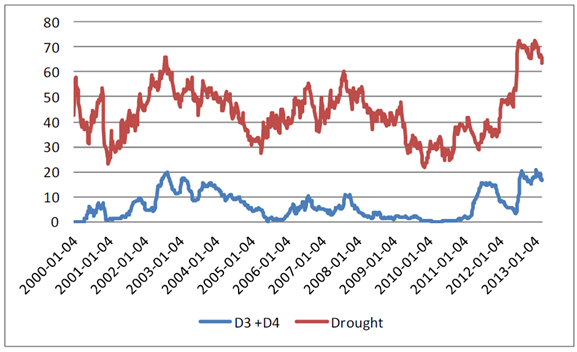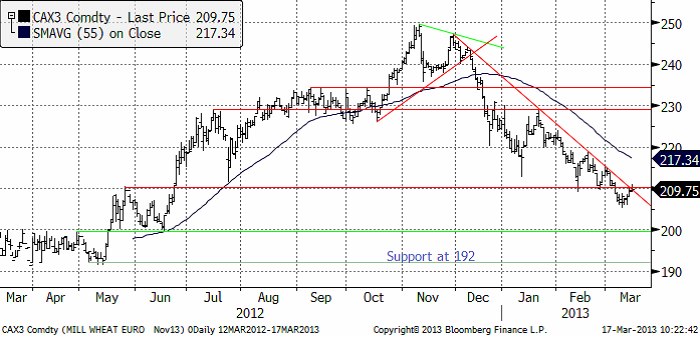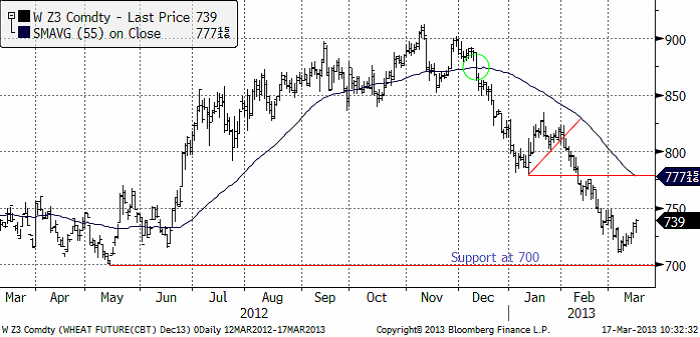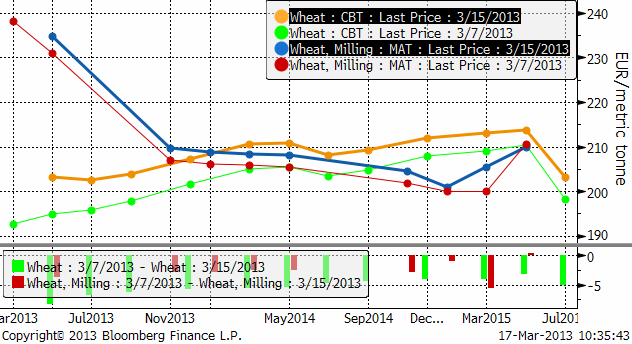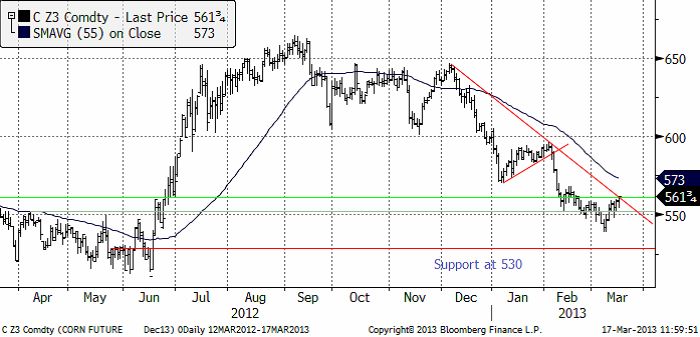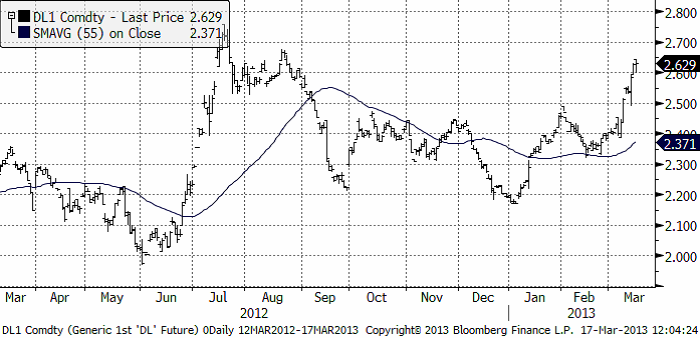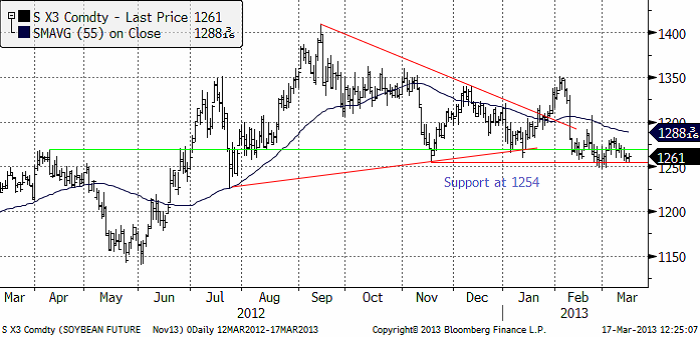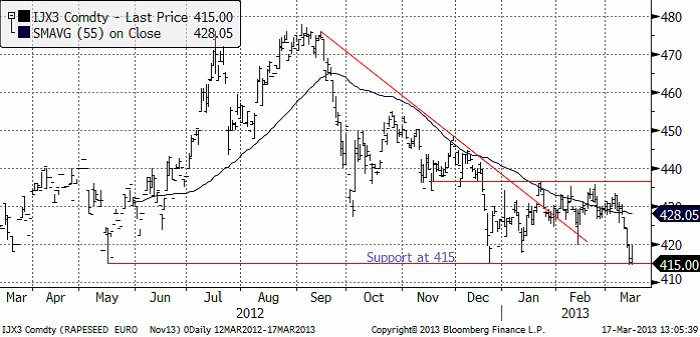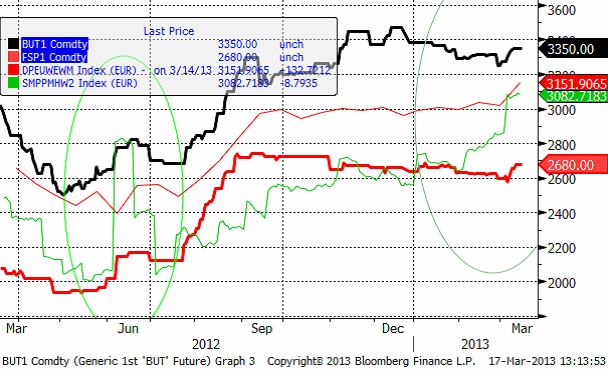Analys
SEB Jordbruksprodukter, 18 mars 2013
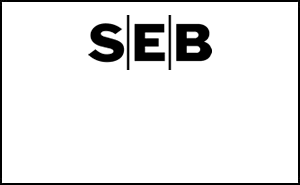
 Prisfallet på spannmål har stannat av och såväl Chicago som Matif hade en av sina bättre veckor på länge. Sojabönorna med rapsfröet i släptåg gick åt motsatt håll, men båda håller sig ännu över sina respektive tekniska stödnivåer. Terminer på mjölkprodukterna smör och SMP steg på den tyska börsen Eurex. På tisdag får vi resultatet av Fonterras senaste auktion.
Prisfallet på spannmål har stannat av och såväl Chicago som Matif hade en av sina bättre veckor på länge. Sojabönorna med rapsfröet i släptåg gick åt motsatt håll, men båda håller sig ännu över sina respektive tekniska stödnivåer. Terminer på mjölkprodukterna smör och SMP steg på den tyska börsen Eurex. På tisdag får vi resultatet av Fonterras senaste auktion.
Den 28 mars är det dags för kvartalsstatistiken från det amerikanska jordbruksdepartementet. Klockan 17 den dagen presenteras uppdaterade siffror på ”prospective plantings” för vete och majs och lagerstatistiken per den första mars.
Odlingsväder
I veckan som gick regnade det i området kring Mississippi-floden, medan de västra delarna var fortsatt torra. Torkan släpper längs Mississippifloden och i östra USA och tränger ut torkan längre mot väster. Fortfarande är stora delar av USA torkdrabbat, men något mindre i veckans rapport. 63.6% av USA:s mark är torrare än normalt. I Juldagens rapport var det som värst med över 72% torrt. 16.5% av USA:s mark är fortfarande extremt eller exceptionellt torr. Även det är en minskning från maximum på över 19% som nåddes den sista januari.
Regn och kyla var på sina håll i USA så besvärande att sådden av majs hindrades. Europa fick nederbörd i veckan. Tidigare i år har Europa fått lite mindre nederbörd än normalt.
Vete
Priset på november (2013) steg upp mot 210-nivån i veckan. Det är ett avgörande läge, eftersom den här prisnivån just nu också är i den övre delen av den trendkanal nedåt som priset legat i sedan början av december när WASDE-rapporten fick marknaden på fall. När man är ute och talar med lantbrukare i Sverige får man höra följande: För det första är det ganska få som hann med att prissäkra på de höga prisnivåerna över 230 euro per ton som marknaden erbjöd mellan augusti och december. Den första stora prisuppgången 2007 var det nästan ingen som sålde eftersom man inte visste hur långt upp priset kunde gå. Vid nästa stora prisuppgång, 2010, prissäkrade man därför för tidigt, redan i september i många fall. Därför ångrade man sig när toppen noterades i februari 2011. Den här gången har man därför väntat – och missat toppen. Därför är det säkert många som kommer att passa på och sälja om priset rekylerar upp till – exempelvis – 220 euro per ton. Detta gör att uppgångar härifrån kan bli ganska begränsade, om inte utbudet i världen skadas allvarligt av försämrade odlingsförhållanden.
Jag tror att prisfallet de tre senaste månaderna är över och att vi får se lite ”sidledes” rörelse de närmaste veckorna. Intresse att prissäkra från lantbrukshåll finns om priserna är lite högre. Utvecklingen på vädret framöver blir viktigt.
Decemberkontraktet på CBOT hade en av sida bättre veckor, även den. Inte för att det är början på en prisuppgång, utan för att priset, som vi skrev förra veckan, kanske gått lite för långt ner lite för hastigt. Prisuppgången kommer alltså trots att det i veckan kom rapporter om ökande nederbörd och avtagande torka. Den enda tolkningen då är rimligen den, att priset gått ner lite för långt.
Terminskurvorna visar att alla terminer stigit. På Matif har alla löptider gått upp lika mycket. I USA har gammal skörd handlats upp mer än ny. Det är rimligt att detta sker, eftersom lagerkostnaderna minskar med minskande lager och att transporterna ut från USA kommer igång igen. Att vete blivit billigare än majs för gammal skörd bidrar också till att dra upp priset på vete.
Det har kommit en del statistik i veckan – som pekar åt olika håll. Franska Cocerals rapport indikerar högre priser. De tror att skörden i Frankrike blir bara något högre och 12 mt lägre i Storbritannien, där sådden var 25% mindre än normalt i höstas. Frankrike, som är EU:s största veteproducent beräknas bara öka skörden marginellt med 0.1 mt till 35.9 mt. Detta beror på att de största odlingsdistrikten Picardie och Centre fick mer än dubbelt så mycket nederbörd som normalt i december. FranceAgriMer estimerar att 66% av den franska veteskörden är i ”good” eller ”very good” condition per den 4 mars. Förra året samma tid var siffran 68%. Det är alltså nästan samma nivå.
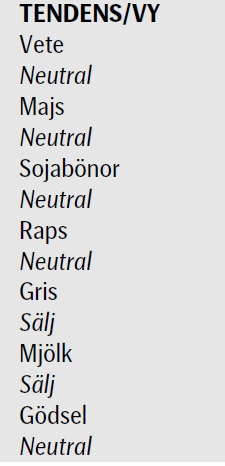 Coceral estimerade den tyska skörden till 23.6 mt, vilket är på samma nivå som DRV (Deutsche Raiffeisenverband) också publicerade i veckan som gick. DRV pekade på att det hittills inte förekommit några övervintringsskador på grund av frost.
Coceral estimerade den tyska skörden till 23.6 mt, vilket är på samma nivå som DRV (Deutsche Raiffeisenverband) också publicerade i veckan som gick. DRV pekade på att det hittills inte förekommit några övervintringsskador på grund av frost.
Spanien, som förra året drabbades av torka, väntas i år producera normalt. Forna öststater väntas fortsätta öka produktionen. I förra veckans WASDE-rapport noterade vi också att den enda justering som USDA gjorde var att höja Litauens skörd med 500,000 ton. Det är en tydlig tendens.
”Soft Wheat” – skörden i EU tror Coceral blir 127.8 mt (+3.2 mt från förra året).
Strategie Grains som också rapporterade i veckan tror att samma skörd blir 131.6 mt. EU-kommissionen tror på ännu högre skörd, 132.1 mt.
Liksom förra veckan tror jag att de tre senaste månadernas prisfall på vete är över. Däremot tror jag inte på någon rask uppgång, utan mer på ”sidledes” rörelse medan marknaden tolkar de rapporter som kommer in – och lagerstatistiken som USDA publicerar den 28 mars. Ska man hålla koll på någonting särskilt är det om 210-nivån på Matif bryts på uppsidan. Det vore ett klart styrketecken om köparna lyckas ta hand om alla säljordrar som troligtvis anhopat sig där.
Maltkorn
Priset på maltkorn med leverans i november har visat mer styrka än kvarnvetet i veckan som gick. Priset steg från 240 till 247, medan kvarnvetet ”bara” steg några euro.
Majs
Majspriset (december 2013) fortsatte att stiga i veckan som gick. Priset gick upp till 561 cent – en nivå som dels ligger an mot den övre trendkanalen och dels är en nivå där uppgångar slutat tidigare. Marknaden står alltså nu under helgen och väger. Om priset håller sig på den här nivån får vi en någorlunda god bekräftelse på att prisfallet från december är över.
Veckovis etanolproduktion i minskade i veckan, men priset på etanol steg kraftigt. Vid årsskiftet handlades etanolen i 2.20 dollar per gallon och nu ligger den på 2.60. Detta sker samtidigt som oljepriset har fallit. Högre pris borde leda till högre produktion och högre efterfrågan på majs.
Vi har samma tolkning av marknaden som förra veckan. Prisfallet har troligtvis ebbat ut och priset bör röra sig ”sidledes”.
Sojabönor
Sojabönorna (november 2013) har till skillnad från majs, vete och maltkorn, handlats ner i veckan som stödet som jag skrivit om tidigare, på 1254 cent, har hållit. Novemberterminen stängde i fredags på 1261.
Skörden i Brasilien har kommit halvvägs. Bönderna har sålt 60% av skörden. Som jag skrev förra veckan är priserna inåt landet pressade på grund av den långsamma exporten. I Paranagua är väntan 75 dagar enligtFryer reports. Argentinska bönder har bara sålt 10% av skörden vilket är mindre än förra året då 30% sålt så här års. Argentina förklarades nästan i konkurs i en domstol i London häromveckan. Det finns därför en anledning att behålla sparkapitalet i den reala och säkra form som sojabönorna utgör.
I fredags publicerade NOPA (National Oilseed Processors Organisation) sin månadsvisa crush report. Den visar att sojabönslagret i USA äts upp i ett rasande tempo, samtidigt som världen får lov att vänta för att kunna få tag på de sydamerikanska bönorna.
Marknadsläget är oförändrat från förra veckan: I veckan som kommer får man hålla koll på om priset håller sig över det tekniska stödet vid 1254 eller om det bryts. Om det bryts vill vi vara korta sojabönor.
Raps
Rapspriset (november 2013) föll i torsdags rakt ner till det tekniska stödet på 415 euro per ton, men vände i fredags upp därifrån till 420, men stängde veckan på exakt 415 euro. Det var stora prisfall även i Winnipeg. Detta ”borde” inte ske ur ett fundamentalt perspektiv eftersom lagren är så små men sojabönorna sjönk och då kan inte rapsen gå sin egen väg.
Olyckligtvis lämnade vi förra veckan en negativ vy på rapsen till nuvarande neutrala. Om marknaden handlar ner priset under 415 går vi omedelbart över till negativ vy igen, annars håller vi fast vid det neutrala. Jag tror inte man bör vara lång raps, så har man raps som inte är prissäkrat bör man överväga att göra det.
Gris
Grispriset (Maj 13) vände ner igen, precis som vi skrev förra veckan. Prisuppgången i början på mars får vi än så länge betrakta som en rekyl mot den i det större perspektivet fallande trenden.
Mjölk
Resultatet för Fonterras auktion presenteras på tisdag. I februari började det priset stiga ordentligt, från 2600 euro per ton till 3082 euro per ton. Den senaste veckan har vi också sett att priserna på Eurex stigit något, men inte alls i samma utsträckning som Fonterra auktionens pris.
I kursdiagrammet nedan ser vi fyra kurvor, som förra veckan. Överst har vi smör i euro per ton, alla är i euro per ton. Den tunna röda linjen USDA:s notering för SMP i västra Europa. Den feta röda linjen är terminspriset på SMP på Eurex, som avser snittpriset på SMP i Tyskland, Holland och Frankrike. Den gröna linjen är Fonterras auktionspris på SMP.
SEB Commodities erbjuder ett litet ”prova-på” kontrakt som består av 0.5 ton Eurex-smör och 0.9 ton Eurex SMP. Ett paket som motsvarar 10 ton flytande mjölkråvara. Just nu är det underliggande värdet på ett sådant kontrakt drygt 33 000 kronor.
Den som vill följa priset på SMP på Eurex gör det via länken:
www.eurexchange.com/exchange-en/products/com/agr/14016/
Vi har säljrekommendation på mjölkterminer.
[box]SEB Veckobrev Jordbruksprodukter är producerat av SEB Merchant Banking och publiceras i samarbete och med tillstånd på Råvarumarknaden.se[/box]
Disclaimer
The information in this document has been compiled by SEB Merchant Banking, a division within Skandinaviska Enskilda Banken AB (publ) (“SEB”).
Opinions contained in this report represent the bank’s present opinion only and are subject to change without notice. All information contained in this report has been compiled in good faith from sources believed to be reliable. However, no representation or warranty, expressed or implied, is made with respect to the completeness or accuracy of its contents and the information is not to be relied upon as authoritative. Anyone considering taking actions based upon the content of this document is urged to base his or her investment decisions upon such investigations as he or she deems necessary. This document is being provided as information only, and no specific actions are being solicited as a result of it; to the extent permitted by law, no liability whatsoever is accepted for any direct or consequential loss arising from use of this document or its contents.
About SEB
SEB is a public company incorporated in Stockholm, Sweden, with limited liability. It is a participant at major Nordic and other European Regulated Markets and Multilateral Trading Facilities (as well as some non-European equivalent markets) for trading in financial instruments, such as markets operated by NASDAQ OMX, NYSE Euronext, London Stock Exchange, Deutsche Börse, Swiss Exchanges, Turquoise and Chi-X. SEB is authorized and regulated by Finansinspektionen in Sweden; it is authorized and subject to limited regulation by the Financial Services Authority for the conduct of designated investment business in the UK, and is subject to the provisions of relevant regulators in all other jurisdictions where SEB conducts operations. SEB Merchant Banking. All rights reserved.
Analys
A sharp weakening at the core of the oil market: The Dubai curve

Down to the lowest since early May. Brent crude has fallen sharply the latest four days. It closed at USD 64.11/b yesterday which is the lowest since early May. It is staging a 1.3% rebound this morning along with gains in both equities and industrial metals with an added touch of support from a softer USD on top.

What stands out the most to us this week is the collapse in the Dubai one to three months time-spread.
Dubai is medium sour crude. OPEC+ is in general medium sour crude production. Asian refineries are predominantly designed to process medium sour crude. So Dubai is the real measure of the balance between OPEC+ holding back or not versus Asian oil demand for consumption and stock building.
A sharp weakening of the front-end of the Dubai curve. The front-end of the Dubai crude curve has been holding out very solidly throughout this summer while the front-end of the Brent and WTI curves have been steadily softening. But the strength in the Dubai curve in our view was carrying the crude oil market in general. A source of strength in the crude oil market. The core of the strength.
The now finally sharp decline of the front-end of the Dubai crude curve is thus a strong shift. Weakness in the Dubai crude marker is weakness in the core of the oil market. The core which has helped to hold the oil market elevated.
Facts supports the weakening. Add in facts of Iraq lifting production from Kurdistan through Turkey. Saudi Arabia lifting production to 10 mb/d in September (normal production level) and lifting exports as well as domestic demand for oil for power for air con is fading along with summer heat. Add also in counter seasonal rise in US crude and product stocks last week. US oil stocks usually decline by 1.3 mb/week this time of year. Last week they instead rose 6.4 mb/week (+7.2 mb if including SPR). Total US commercial oil stocks are now only 2.1 mb below the 2015-19 seasonal average. US oil stocks normally decline from now to Christmas. If they instead continue to rise, then it will be strongly counter seasonal rise and will create a very strong bearish pressure on oil prices.
Will OPEC+ lift its voluntary quotas by zero, 137 kb/d, 500 kb/d or 1.5 mb/d? On Sunday of course OPEC+ will decide on how much to unwind of the remaining 1.5 mb/d of voluntary quotas for November. Will it be 137 kb/d yet again as for October? Will it be 500 kb/d as was talked about earlier this week? Or will it be a full unwind in one go of 1.5 mb/d? We think most likely now it will be at least 500 kb/d and possibly a full unwind. We discussed this in a not earlier this week: ”500 kb/d of voluntary quotas in October. But a full unwind of 1.5 mb/d”
The strength in the front-end of the Dubai curve held out through summer while Brent and WTI curve structures weakened steadily. That core strength helped to keep flat crude oil prices elevated close to the 70-line. Now also the Dubai curve has given in.

Brent crude oil forward curves

Total US commercial stocks now close to normal. Counter seasonal rise last week. Rest of year?

Total US crude and product stocks on a steady trend higher.

Analys
OPEC+ will likely unwind 500 kb/d of voluntary quotas in October. But a full unwind of 1.5 mb/d in one go could be in the cards

Down to mid-60ies as Iraq lifts production while Saudi may be tired of voluntary cut frugality. The Brent December contract dropped 1.6% yesterday to USD 66.03/b. This morning it is down another 0.3% to USD 65.8/b. The drop in the price came on the back of the combined news that Iraq has resumed 190 kb/d of production in Kurdistan with exports through Turkey while OPEC+ delegates send signals that the group will unwind the remaining 1.65 mb/d (less the 137 kb/d in October) of voluntary cuts at a pace of 500 kb/d per month pace.

Signals of accelerated unwind and Iraqi increase may be connected. Russia, Kazakhstan and Iraq were main offenders versus the voluntary quotas they had agreed to follow. Russia had a production ’debt’ (cumulative overproduction versus quota) of close to 90 mb in March this year while Kazakhstan had a ’debt’ of about 60 mb and the same for Iraq. This apparently made Saudi Arabia angry this spring. Why should Saudi Arabia hold back if the other voluntary cutters were just freeriding? Thus the sudden rapid unwinding of voluntary cuts. That is at least one angle of explanations for the accelerated unwinding.
If the offenders with production debts then refrained from lifting production as the voluntary cuts were rapidly unwinded, then they could ’pay back’ their ’debts’ as they would under-produce versus the new and steadily higher quotas.
Forget about Kazakhstan. Its production was just too far above the quotas with no hope that the country would hold back production due to cross-ownership of oil assets by international oil companies. But Russia and Iraq should be able to do it.
Iraqi cumulative overproduction versus quotas could reach 85-90 mb in October. Iraq has however steadily continued to overproduce by 3-5 mb per month. In July its new and gradually higher quota came close to equal with a cumulative overproduction of only 0.6 mb that month. In August again however its production had an overshoot of 100 kb/d or 3.1 mb for the month. Its cumulative production debt had then risen to close to 80 mb. We don’t know for September yet. But looking at October we now know that its production will likely average close to 4.5 mb/d due to the revival of 190 kb/d of production in Kurdistan. Its quota however will only be 4.24 mb/d. Its overproduction in October will thus likely be around 250 kb/d above its quota with its production debt rising another 7-8 mb to a total of close to 90 mb.
Again, why should Saudi Arabia be frugal while Iraq is freeriding. Better to get rid of the voluntary quotas as quickly as possible and then start all over with clean sheets.
Unwinding the remaining 1.513 mb/d in one go in October? If OPEC+ unwinds the remaining 1.513 mb/d of voluntary cuts in one big go in October, then Iraq’s quota will be around 4.4 mb/d for October versus its likely production of close to 4.5 mb/d for the coming month..
OPEC+ should thus unwind the remaining 1.513 mb/d (1.65 – 0.137 mb/d) in one go for October in order for the quota of Iraq to be able to keep track with Iraq’s actual production increase.
October 5 will show how it plays out. But a quota unwind of at least 500 kb/d for Oct seems likely. An overall increase of at least 500 kb/d in the voluntary quota for October looks likely. But it could be the whole 1.513 mb/d in one go. If the increase in the quota is ’only’ 500 kb/d then Iraqi cumulative production will still rise by 5.7 mb to a total of 85 mb in October.
Iraqi production debt versus quotas will likely rise by 5.7 mb in October if OPEC+ only lifts the overall quota by 500 kb/d in October. Here assuming historical production debt did not rise in September. That Iraq lifts its production by 190 kb/d in October to 4.47 mb/d (August level + 190 kb/d) and that OPEC+ unwinds 500 kb/d of the remining quotas in October when they decide on this on 5 October.

Analys
Modest draws, flat demand, and diesel back in focus

U.S. commercial crude inventories posted a marginal draw last week, falling by 0.6 million barrels to 414.8 million barrels. Inventories remain 4% below the five-year seasonal average, but the draw is far smaller than last week’s massive 9.3-million-barrel decline. Higher crude imports (+803,000 bl d WoW) and steady refinery runs (93% utilization) helped keep the crude balance relatively neutral.

Yet another drawdown indicates commercial crude inventories continue to trend below the 2015–2022 seasonal norm (~440 million barrels), though at 414.8 million barrels, levels are now almost exactly in line with both the 2023 and 2024 trajectory, suggesting stable YoY conditions (see page 3 attached).
Gasoline inventories dropped by 1.1 million barrels and are now 2% below the five-year average. The decline was broad-based, with both finished gasoline and blending components falling, indicating lower output and resilient end-user demand as we enter the shoulder season post-summer (see page 6 attached).
On the diesel side, distillate inventories declined by 1.7 million barrels, snapping a two-week streak of strong builds. At 125 million barrels, diesel inventories are once again 8% below the five-year average and trending near the low end of the historical range.
In total, commercial petroleum inventories (excl. SPR) slipped by 0.5 million barrels on the week to ish 1,281.5 million barrels. While essentially flat, this ends a two-week streak of meaningful builds, reflecting a return to a slightly tighter situation.
On the demand side, the DOE’s ‘products supplied’ metric (see page 6 attached), a proxy for implied consumption, softened slightly. Total demand for crude oil over the past four weeks averaged 20.5 million barrels per day, up just 0.9% YoY.
Summing up: This week’s report shows a re-tightening in diesel supply and modest draws across the board, while demand growth is beginning to flatten. Inventories remain structurally low, but the tone is less bullish than in recent weeks.

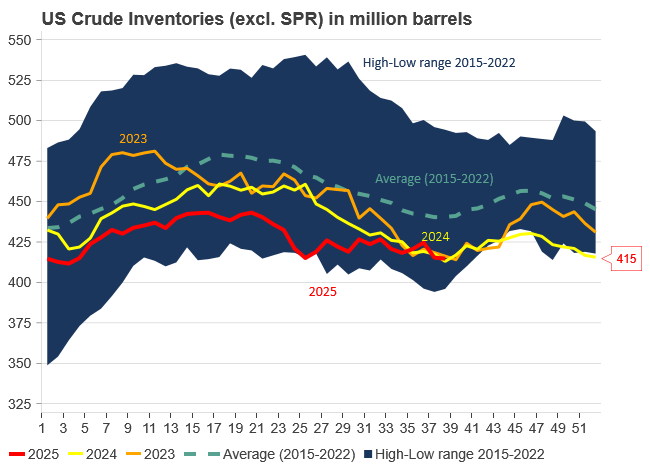
-

 Nyheter4 veckor sedan
Nyheter4 veckor sedanEurobattery Minerals satsar på kritiska metaller för Europas självförsörjning
-

 Nyheter3 veckor sedan
Nyheter3 veckor sedanMahvie Minerals i en guldtrend
-

 Nyheter4 veckor sedan
Nyheter4 veckor sedanGuldpriset kan närma sig 5000 USD om centralbankens oberoende skadas
-
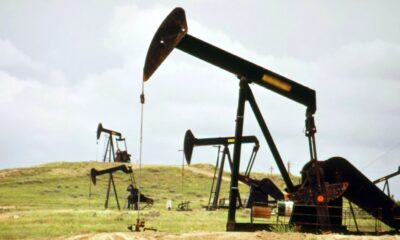
 Nyheter4 veckor sedan
Nyheter4 veckor sedanOPEC signalerar att de inte bryr sig om oljepriset faller kommande månader
-

 Analys3 veckor sedan
Analys3 veckor sedanVolatile but going nowhere. Brent crude circles USD 66 as market weighs surplus vs risk
-

 Nyheter3 veckor sedan
Nyheter3 veckor sedanAktier i guldbolag laggar priset på guld
-

 Nyheter3 veckor sedan
Nyheter3 veckor sedanKinas elproduktion slog nytt rekord i augusti, vilket även kolkraft gjorde
-

 Nyheter2 veckor sedan
Nyheter2 veckor sedanTyskland har så höga elpriser att företag inte har råd att använda elektricitet


